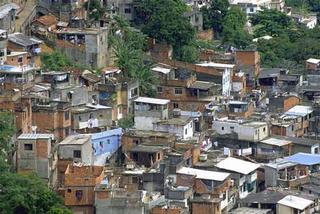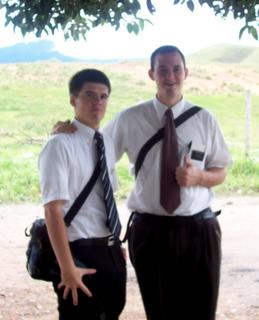
"I remember when we went to Ensenada, Mexico there was one way poor lady on the street and Mike McDonald, being the kind hearted fella that he is, decided to buy like 10 bucks worth of chiclets off of her. Well, Brasil is really poor as well. Like it was a suprise to me when I first got here to see what's called "favelas". They are pretty much homemade homes, built from scrap metal, old wood, tarps, mud and cement. There is a movie made about them called Cidade de Deus, which means City of God, that you could rent. I think it's all about favelas, but it's way way violent, or so I've heard. Check it out. One of the biggest favelas in Brasil is about 1 or 2 miles from the mission office in Sao Paulo."
Favela is a term commonly used in Brazil to describe areas such as shanty towns or slums. The term favela comes from the Morro de Favela hillside in Rio de Janeiro, where freed slaves first established a community of squatters in the 1890s.
A favela is fundamentally different from a slum or tenement, primarily in terms of its origin and location. While slum quarters in other Latin American countries are generally started as poorer residents from the countryside come to larger cities in search of work, favelas are unique in that they were created as a large population becomes displaced.
Favelas are units of irregular self-constructed housing that are occupied illegally. They are usually on lands belonging to third parties, and most often located on the urban periphery. Residences are built without a license and with little or no sanitation. Favelas are often characterized by an almost total absence of numbered streets, sanitation networks, electricity, telephone service, or plumbing.
These areas of irregular and poor quality housing are often crowded onto hillsides. Accidents in such areas, caused primarily by heavy rainfall, are frequent. Favelas are often troubled by drug-related crime and gang warfare. There are rumors that common social codes in favelas forbid residents from engaging in criminal activity while inside their own favela. Favelas are often considered a disgrace within Brazil.
People that live in favelas, known as favelados, are often very poor. Many live below the poverty line on less than 100 US$ per month. Brazil's favelas can be seen as a consequence of the unequal distribution of wealth in the country.
The most famous favelas are those in and around Rio de Janeiro, where they provide a dramatic illustration of the gap between poverty and wealth, positioned side-by-side with the luxurious apartment buildings and mansions of Rio's elite. Several hills in Rio are plastered with favelas. In 2004, it was estimated that 30% of Rio's population lives within favelas. São Paulo also has a large number of favelas.












